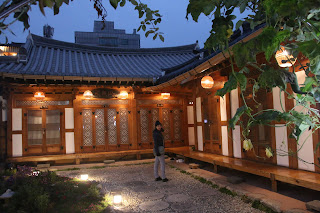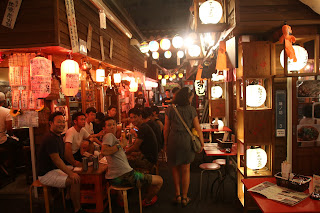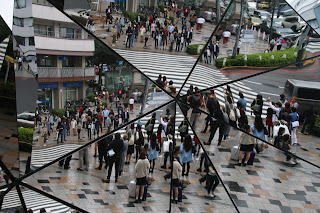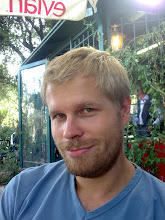Our Korean adventure continues in another historic town called Jeonju. If Gyeongju was marked by the Silla dynasty, Jeonju is marked by Joseon dynasty, which originated here. Jeonju is famous for two things mainly: its gastronomy and its large concentration of traditional Hanok houses.
We had a taste of both right upon arrival. We stayed in a lovely Hanok house right in the middle of the old town. Again, our room was very sparsely decorated, but hey, we want the real thing, right!
We also got to try the local gastronomy, which was more of an "acquired taste", shall we say. As we arrived very late (like last night in Gyeongju), most restaurants were closed, so we followed the advice of our extremely friendly host and went to a restaurant specializing in soya bean sprout soup. Well, actually, they only serve that. Now, I don't have anyting against soya bean sprouts, they make a great addition to dishes, but a soup which is literally just soya bean sprouts, let me tell you, it gets pretty tedious quickly... Oh well...
The next day, we got up bright and early and headed off to explore town. We started off by climbing up a small hill, located just next to the old town. We were treated to some quite nice views over the old town with its Hanok houses (doted with beautiful wooden rooftops).
Across the road on another hilltop, we decided to check out Jaman Mural Village. It's a residential part of town, not particularly picturesque as such, that basically decided to paint murals all over the houses lining the roads. Think Mission District the Korean Way. Except, the murals in the Mission District (you know, in San Francisco) are quite a bit more impressive than here... I did get to pose next to Captain America though, so who am I to complain ? ;-)
Then for a bit of history again, and decided to check out yet another place with a completely unpronounceable name (actually, that goes for pretty much all Korean names!) Jeonjuhyanggyo - a Confucian School. Confucianism (a philosophy which puts great emphasis on education) is a big thing in Korea - or Neo-Confucianism, rather. It was possibly my favourite spot in Jeonju - a rather peaceful and refreshingly not touristy spot - what's cool was that there was some kind of ceremony taking place with lots of chaps dressed in traditional Korean dress.
We continued our exploration of Jeonju by heading off to the farmer's market - a pretty lively and busy place - the sort of place we like checking out. There was supposed to be a collection of quirky shops above the farmer's market - but it seems that the shops are closed on Sunday, unfortunately!
Our continued exploration of Jeonju confirmed two things to us. Firstly, Korean ladies LOVE dressing up in traditional Korean dress. Without exaggerating, every second lady we ran into in the street was wearing one, I kid you not. (it also appears that one shop in two rent these dresses). Secondly, Koreans are the kings/queens of selfies - in particular if they are dressed in traditional Korean dress. it was kind of funny to observe in the beginning, but the charm does wear off rather quickly...
We next headed off to Gyeonggijeon, which is one of the top sites in Joenju - due to the fact that the mortuary tablets and portraits of several monarchs are on display here. It's also THE place in Joenju to dress up in traditional Korean dress and take selfies, apparently (and that's saying a lot!).
Next up was a late-ish lunch - we decided to have Bibimbap, a local speciality of Joenju (which is, remember, the culinary capital of Korea). Basically it's a bowl of rice, mixed with a hot chilly paste, a raw egg, fermented soya bean paste (it's Korean, so it must contain something fermented), soya sauce, some meat and vegetables. It's a bit of an acquired taste - but I enjoyed it.
We spent the rest of the day wandering around in the picturesque old town, stopping for the odd cappuccino (one cool thing about Korea is that they have very cozy cafes - even if the coffee tends to be a bit pricey). It really is a very pretty town to wander around - it's rare to find a place with such a well preserved & architecturally harmonious historic old town, especially in Asia. It's just a pity the place is overrun by tourists and selfie-fanatics...
Come nightfall, it was time for us to jump on the train back to Seoul!
We had a taste of both right upon arrival. We stayed in a lovely Hanok house right in the middle of the old town. Again, our room was very sparsely decorated, but hey, we want the real thing, right!
We also got to try the local gastronomy, which was more of an "acquired taste", shall we say. As we arrived very late (like last night in Gyeongju), most restaurants were closed, so we followed the advice of our extremely friendly host and went to a restaurant specializing in soya bean sprout soup. Well, actually, they only serve that. Now, I don't have anyting against soya bean sprouts, they make a great addition to dishes, but a soup which is literally just soya bean sprouts, let me tell you, it gets pretty tedious quickly... Oh well...
The next day, we got up bright and early and headed off to explore town. We started off by climbing up a small hill, located just next to the old town. We were treated to some quite nice views over the old town with its Hanok houses (doted with beautiful wooden rooftops).
Across the road on another hilltop, we decided to check out Jaman Mural Village. It's a residential part of town, not particularly picturesque as such, that basically decided to paint murals all over the houses lining the roads. Think Mission District the Korean Way. Except, the murals in the Mission District (you know, in San Francisco) are quite a bit more impressive than here... I did get to pose next to Captain America though, so who am I to complain ? ;-)
Then for a bit of history again, and decided to check out yet another place with a completely unpronounceable name (actually, that goes for pretty much all Korean names!) Jeonjuhyanggyo - a Confucian School. Confucianism (a philosophy which puts great emphasis on education) is a big thing in Korea - or Neo-Confucianism, rather. It was possibly my favourite spot in Jeonju - a rather peaceful and refreshingly not touristy spot - what's cool was that there was some kind of ceremony taking place with lots of chaps dressed in traditional Korean dress.
We continued our exploration of Jeonju by heading off to the farmer's market - a pretty lively and busy place - the sort of place we like checking out. There was supposed to be a collection of quirky shops above the farmer's market - but it seems that the shops are closed on Sunday, unfortunately!
Our continued exploration of Jeonju confirmed two things to us. Firstly, Korean ladies LOVE dressing up in traditional Korean dress. Without exaggerating, every second lady we ran into in the street was wearing one, I kid you not. (it also appears that one shop in two rent these dresses). Secondly, Koreans are the kings/queens of selfies - in particular if they are dressed in traditional Korean dress. it was kind of funny to observe in the beginning, but the charm does wear off rather quickly...
We next headed off to Gyeonggijeon, which is one of the top sites in Joenju - due to the fact that the mortuary tablets and portraits of several monarchs are on display here. It's also THE place in Joenju to dress up in traditional Korean dress and take selfies, apparently (and that's saying a lot!).
Next up was a late-ish lunch - we decided to have Bibimbap, a local speciality of Joenju (which is, remember, the culinary capital of Korea). Basically it's a bowl of rice, mixed with a hot chilly paste, a raw egg, fermented soya bean paste (it's Korean, so it must contain something fermented), soya sauce, some meat and vegetables. It's a bit of an acquired taste - but I enjoyed it.
We spent the rest of the day wandering around in the picturesque old town, stopping for the odd cappuccino (one cool thing about Korea is that they have very cozy cafes - even if the coffee tends to be a bit pricey). It really is a very pretty town to wander around - it's rare to find a place with such a well preserved & architecturally harmonious historic old town, especially in Asia. It's just a pity the place is overrun by tourists and selfie-fanatics...
Come nightfall, it was time for us to jump on the train back to Seoul!



























































